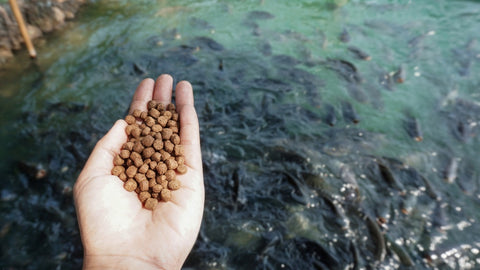on all orders over £75

What Bait To Use When Fishing For Carp?
Are you interested in carp fishing? Fishing is more than just a pastime - it's a genuine adventure that holds a unique allure in the fishing community. These large, intelligent fish have captivated fishermen worldwide. The thrill of catching a powerful fighter or the difficulty of selecting the right carp bait is unmatched. The excitement is what attracts fishermen to the water's edge.
Deciding on the key components of effective carp bait involves more than just capturing the attention of the fish. Understanding carp behaviour, local conditions, and being creative is essential in this fusion of art and science. Carp have a diverse diet, yet it's crucial to select the appropriate bait for successful fishing, as they can also be selective eaters.
In this comprehensive guide, we will explore the realm of carp bait, covering natural alternatives that imitate wild carp diets and modern artificial options that are revolutionising the sport. If you're an experienced carp angler or new to the hobby, learning about the top baits will help improve your abilities in carp fishing. Therefore, get your equipment ready and begin this adventure to discover the mysteries behind successful carp fishing.
Understanding Carp
The increase in Carp fishing's popularity is not only due to the thrill of catching them, but also to the fascinating characteristics of Carp. Becoming proficient at catching these hard-to-catch fish necessitates a strong grasp of their habits and likes.
Carp includes many different species with a range of characteristics. Not only the Common Carp is famous; the Mirror, Leather, and Grass Carp also have their unique behaviors. For example, Common Carp can adapt to various types of water habitats, such as sluggish rivers and big, nutrient-filled lakes, whereas Grass Carp prefer areas with abundant aquatic plants and primarily feed on them.

Carp exhibit a variety of feeding habits that correspond to their diverse environments. Usually found at the bottom, these fish search for food in mud and debris. Because they are scavengers, they have a diverse diet that includes aquatic insects, crustaceans, and plant material. Their ability to be adaptable enables them to change their preferences depending on what is accessible, which makes it more difficult to target them.
Carp are renowned for their wariness and intelligence, becoming cautious in the presence of anglers, particularly in busy waters. This intelligence adds an extra layer of challenge to Carp fishing, requiring anglers to be more strategic in their baiting approach.
Environmental factors, such as water temperature, significantly influence Carp's behavior and feeding habits. In warmer temperatures, Carp are generally more active and feed more aggressively, while in colder conditions, they become lethargic and feed less.
Understanding these nuances is essential for any angler looking to successfully target Carp. This knowledge informs the choice of bait, the fishing approach, and ultimately, the success in landing these fascinating fish. With this as our foundation, let's now delve into the various effective bait options for catching Carp.

Which Natural Carp Bait To Use?
The variety of natural bait options for Carp is extensive, each with its own special attraction and way of being presented. Knowing the appropriate times and techniques for using these baits can greatly improve your Carp fishing success.
Boilies
Boilies have become very popular in Carp fishing because of their versatility and effectiveness. These compact, spherical baits are crafted from a mixture of ingredients such as fishmeal, milk proteins, bird food, and flavors. The key to successful boilie fishing lies in matching the flavor and size to the Carp's natural feeding preferences in your fishing location.
For setting up, boilies are often paired with a hair rig to ensure that the Carp can easily ingest the bait. This also enables the use of larger boilies, which can be beneficial in areas with smaller nuisance fish. Boilies can also be used with a technique known as "baiting up," where you disperse several boilies to establish a feeding area, attracting Carp and encouraging them to feed confidently.

Worms
Carp find worms to be a natural and highly nutritious food source, which makes them an excellent choice for bait. They are particularly effective during colder months or in heavily fished waters where Carp have become cautious of more common baits.
When using worms, you have the option to thread several onto the hook to create a substantial offering or use just one. Worms can be presented in various ways. They can be used on the bottom, under a float, or even by free-lining, depending on the water conditions and the behavior of the Carp. The natural wriggling motion of the worms is very appealing to Carp and often triggers an instinctive feeding response.
Maggots
During the winter when Carp's metabolism slows down, maggots are a great bait option, especially as Carp prefer an easy meal. It's best to use these small baits in a bunch, either by threading them onto the hook or attaching them using a maggot clip. This approach creates a clustered ball of bait that is both highly visible and appealing to Carp.
When it comes to presentation, you can fish maggots on the bottom or slightly above using a technique known as the "maggot feeder." This method involves using a feeder filled with maggots that are gradually released, creating a bait bed that attracts Carp to your hook. Another option is to combine maggots with ground bait to create a more enticing feeding area.
Sweetcorn
Sweetcorn is not only a popular snack among humans. It is equally enticing to carp due to its sweetness and vibrant color. This bait is especially effective in bodies of water where carp have a diverse diet that includes plant matter. The bright yellow kernels are visually appealing, especially in waters with low visibility or silt.
You have the option to either thread the corn directly onto your hook or use it on a hair rig. To enhance its presentation, you can use multiple kernels to form a larger and more appealing target. The natural sugars in the corn also emit an aroma, thereby increasing its effectiveness.
When it comes to method, sweetcorn is effective at both bottom and mid-water levels. It has a light enough weight to be carried by gentle currents, resulting in a realistic presentation that Carp will struggle to ignore. Sprinkling a few kernels in the area can also attract Carp to your fishing spot, improving your likelihood of getting a bite.
Bread
Bread, a deceptively simple bait, can be extremely successful for catching Carp, especially when fishing on the water's surface. Specifically in urban areas where Carp are accustomed to being fed by people, bread can entice them to come to the surface. Properly shaping the bread onto the hook to keep it afloat is crucial when using this method. A common approach involves tearing off a portion of bread, lightly moistening it, and then carefully wrapping it around the hook, ensuring enough of the hook is exposed to snag the fish.
When fishing with bread on the surface, patience and a sharp eye are essential because you need to wait for Carp to grab the bait from the top. This technique can be quite exciting as you witness the Carp gulping down the bait. During colder months, bread can also be utilized at the bottom. You can achieve unexpected results by pinching a small piece of bread around the hook and casting it into promising Carp locations.
Best Artificial Baits for Carp
For Carp fishing, natural baits are effective, but artificial baits provide a more convenient option. These baits have advanced to closely imitate the look and smell of natural food sources.
Pellets
Pellets for Carp are formulated to mimic the high-protein food pellets commonly utilised in Carp breeding. They are available in a range of sizes, flavors, and colors, enabling anglers to customize their approach based on the specific circumstances and Carp preferences. Pellets can be used alone or in conjunction with other baits, like boilies or natural baits, to establish a more varied feeding area.
Regarding presentation, pellets are effective in a bait feeder or as part of a method feeder setup. They dissolve slowly, releasing scent and flavor into the water, which can lure Carp from a distance. Experimenting with different flavors and sizes can help determine the most efficient combination for your particular fishing spot.

Artificial Corn
Artificial corn has gained popularity in Carp fishing for its effectiveness and ease of use, just like real corn. It closely resembles the look and feel of real corn while offering the advantage of being durable and reusable. Some types of artificial corn even come with scents, making them even more attractive. Rigging artificial corn is simple and can be done on a hair rig.
When using artificial corn, it's beneficial to combine it with a real kernel or two. This combination can be more enticing, providing both the visual appeal and the natural scent of real corn.

Bait and Environment
Please consider how the bait you use might affect the local environment. Introducing non-native baits can disturb the natural balance in unfamiliar water systems. It is better to choose biodegradable and eco-friendly baits to reduce possible harm. Additionally, refrain from overfeeding, as excessive bait can cause water pollution and disrupt the natural feeding habits of fish.
Educating and Learning
Openness to learning and teaching others is essential for ethical fishing practices. It's important to share best practices with fellow anglers, especially those who are new to the sport, and to remain open to learning from others. By coming together as an angling community, we can have a meaningful impact on promoting sustainable and ethical Carp fishing practices.
